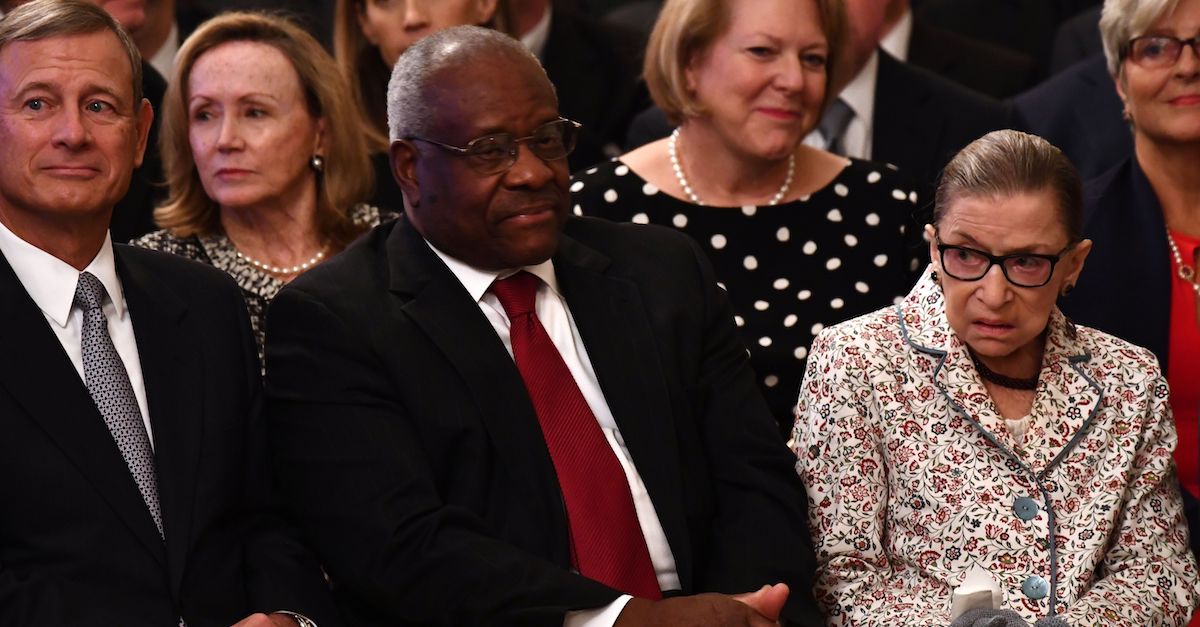
Supreme Court Justice Clarence Thomas on Tuesday denied a Bill Cosby accuser’s petition to have her dismissed defamation case against the now-incarcerated convicted sex offender reviewed by the highest court in the land. He then went out of his way—and to great lengths—to explain why he wants to unravel the fabric of modern defamation law.
Thomas agreed with the denial of Kathrine Mae McKee‘s petition for a writ of certiorari because he felt it dealt with an issue of fact that is inappropriate for the Supreme Court. Nevertheless, Thomas engaged in a legal argument that showed great disdain for the 1964 Supreme Court decision in New York Times Co. v. Sullivan, which established the “actual malice” standard for public figures in libel law. What this meant was that public figures could not sue for libel or slander unless they could reach the “almost impossible” standard (Thomas’ words) of proving actual malice, which is means having knowledge that a statement was false or showing reckless disregard for whether a statement is true.
This was a view that was immediately met with some raised eyebrows.
Thomas began by summarizing the context of the McKee case. McKee accused Cosby of raping her four decades ago and said that a Cosby attorney wrote and leaked a “defamatory letter” that McKee said was done to “damage her reputation for truthfulness and honesty, and further to embarrass, harass, humiliate, intimidate, and shame [her].” McKee filed a lawsuit but saw that case dismissed at the state level.
That’s where the railing against New York Times Co. v. Sullivan began; it did not stop until Thomas had spoken his mind.
He noted that “[u]nder this Court’s First Amendment precedents, public figures are barred from recovering damages for defamation unless they can show that the statement at issue was made with ‘actual malice’—that is, with knowledge that it was false or with reckless disregard of whether it was false or not.” He also noted that McKee was classified as a “limited-purpose” public figure in her case, which led to the dismissal of her claim.
Thomas got the crux of the matter here: “I agree with the Court’s decision not to take up that factbound question” — whether McKee truly is a “limited-purpose” public figure. “I write to explain why, in an appropriate case, we should reconsider the precedents that require courts to ask it in the first place.”
In other words, Thomas isn’t a fan that he has to make a decision about this at all because he thinks New York Times Co. v. Sullivan amounted to judicial lawmaking.
“New York Times and the Court’s decisions extending it were policy-driven decisions masquerading as constitutional law. Instead of simply applying the First Amend- ment as it was understood by the people who ratified it, the Court fashioned its own ‘federal rule[s]’ by balancing the ‘competing values at stake in defamation suits,’ Thomas said. “We should not continue to reflexively apply this policy-driven approach to the Constitution. Instead, we should carefully examine the original meaning of the First and Fourteenth Amendments. If the Constitution does not require public figures to satisfy an actual-malice standard in state-law defamation suits, then neither should we.”
After some lengthy wrangling with the legal issues, Thomas said that common law informed the First and Fourteenth Amendments and already provided protections for the “core private righ[t]” of a person’s “‘uninterrupted enjoyment of . . . his reputation.'” He said that the states have all of the authority they need already to handle libel/defamation issues on their own.
“Before our decision in New York Times, we consistently recognized that the First Amendment did not displace the common law of libel. As Justice Story explained, ‘The liberty of speech, or of the press, has nothing to do with this subject. They are not endangered by the punishment of libellous publications. The liberty of speech and the liberty of the press do not authorize malicious and injurious defamation,'” Thomas said. “New York Times marked a fundamental change in the relationship between the First Amendment and state libel law.”
In closing, Thomas said that we “did not begin meddling in this area until 1964, nearly 175 years after the First Amendment was ratified” and that the Supreme Court should reconsider that when the right case comes along.
“The States are perfectly capable of striking an acceptable balance between encouraging robust public discourse and providing a meaningful remedy for reputational harm,” he added. “We should reconsider our jurisprudence in this area.”
Thomas is only one of nine justices, but effects of such jurisprudential reevaluation could be far-reaching. With the removal of the actual malice standard, it would be a lot easier for public figures to sue media, for instance, who write stories that turn out to be false, even if writing a false story was not the intent. In short, they could sue for being defamed regardless of the offending person’s/entities’ intent.
[Image via Brendan Smialowski/Getty Images]